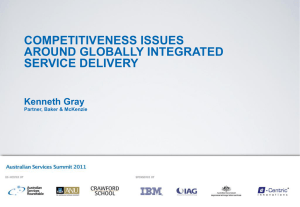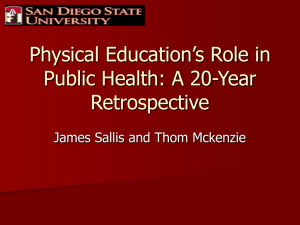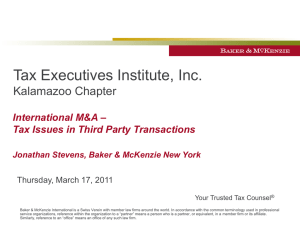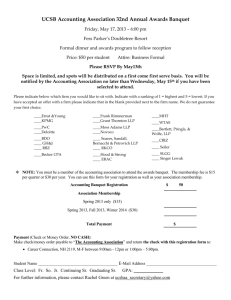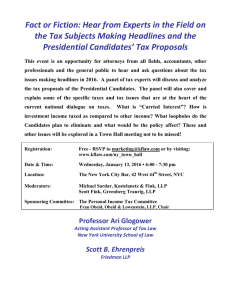How BEPS May Impact Your Business
advertisement
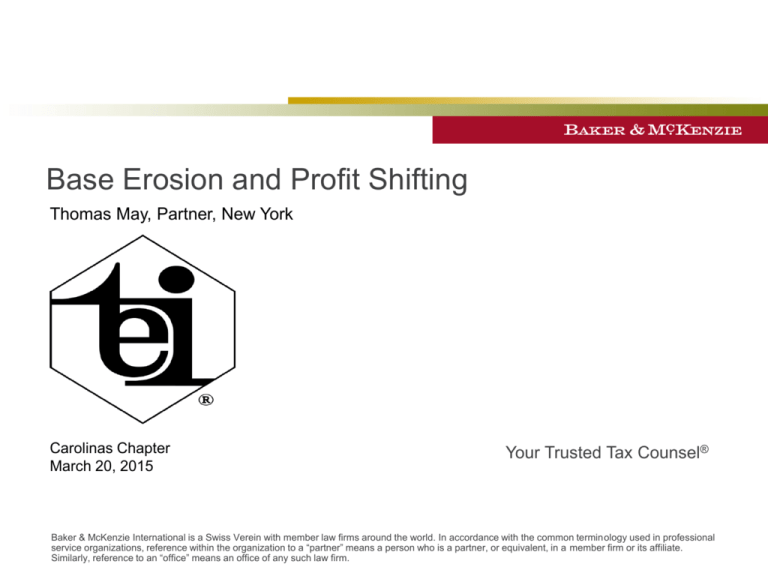
Base Erosion and Profit Shifting Thomas May, Partner, New York Carolinas Chapter March 20, 2015 Your Trusted Tax Counsel® Baker & McKenzie International is a Swiss Verein with member law firms around the world. In accordance with the common terminology used in professional service organizations, reference within the organization to a “partner” means a person who is a partner, or equivalent, in a member firm or its affiliate. Similarly, reference to an “office” means an office of any such law firm. OECD BEPS Project [change title in View/Header and Footer] 2 ©2015 Baker & McKenzie LLP 2 Recent OECD BEPS Discussion Drafts Action 1: VAT B2C Guidelines (Dec. 18) Action 4: Limit Base Erosion via Interest, etc. (Dec. 18) Action 6: Treaty Abuse (Nov. 21) Action 7: Prevent Artificial Avoidance of PE Status (Oct. 31) Actions 8-10: Commodity Transactions (Dec. 16) Actions 8-10: Profit Splits (Dec. 16) Actions 8-10: Risk / Recharacterization (Dec. 19) Action 10: Low ValueAdding Services (Nov. 3) Action 14: Make Dispute Resolution More Effective (Dec. 18) ©2015 Baker & McKenzie LLP 3 Unilateral vs. Multilateral Action on BEPS –A lack of resolution on BEPS is resulting in many countries contemplating unilateral action – U.S. Senator Chuck Schumer –Some countries may have decided to use the opportunity they had at the time to do what they thought was best – Raphaele Russo, Head of OECD BEPS –More than 30 unilateral BEPS-focused measures were introduced by at least 19 countries in 2014 – PwC Survey ©2015 Baker & McKenzie LLP 4 European Union [change title in View/Header and Footer] 5 ©2015 Baker & McKenzie LLP 5 European Union –Ruling Practice – State aid investigation into ruling practices of member states including Luxembourg (Fiat and Amazon), Ireland (Apple), Netherlands (Starbucks), Belgium, Gibraltar, etc. – Transfer pricing rulings, excess profits rulings, source of income rulings, etc. – If rulings constitute state aid, the companies to which they were granted would be required to repay any taxes saved plus interest ©2015 Baker & McKenzie LLP 6 European Union –Transfer pricing ruling USCO CV Royalties BV 3d Party Royalties ©2015 Baker & McKenzie LLP 7 European Union –Ruling Practice – Tax transparency measures – Every three months, national tax authorities of member states will be required to send a short report to all other Member States on all cross-border tax rulings that they have issued – Member States will then be able to ask for more detailed information on a particular ruling – Other transparency proposals ©2015 Baker & McKenzie LLP 8 United States [change title in View/Header and Footer] 9 ©2015 Baker & McKenzie LLP 9 United States –A Unilateral Precursor to BEPS? – Section 7701(o) economic substance doctrine – transaction has economic substance only if transaction changes in meaningful way taxpayer's economic position and taxpayer has substantial purpose (apart from Federal income tax effects) for entering into transaction – legislative history provides that the choice to utilize a related-party entity in a transaction, provided that the arm's length standard of section 482 and other applicable concepts are satisfied ©2015 Baker & McKenzie LLP 10 United States – Caterpillar Parts Before 3d Party CAT CSARL 3d Party After 3d Party CSARL 3d Party ©2015 Baker & McKenzie LLP 11 United States –Senate Permanent Subcommittee on Investigations – IRS should analyze transfer pricing under economic substance, assignment of income, etc. – Transfer pricing agreements should identify, explain and justify profit allocation – Participate in OECD efforts – Eliminate auditing and tax consulting conflicts of interest –IRS is asserting “substance over form” and “assignment of income” ©2015 Baker & McKenzie LLP 12 United Kingdom [change title in View/Header and Footer] 13 ©2015 Baker & McKenzie LLP 13 United Kingdom –Diverted profits tax (2015) – 25% tax (rather than normal rate of 20%) imposed on diverted profits where there is: – an overseas or UK mismatch involving a low-tax entity that lacks economic substance, or – a main purpose is tax avoidance – Charging and notification mechanisms –Hybrid mismatch rules (2017) –Country by country reporting (2015) ©2015 Baker & McKenzie LLP 14 United Kingdom –Hybrid Entity Structure USCO CV Loan BV Loan UKCO ©2015 Baker & McKenzie LLP 15 United Kingdom –No Hybrid Entity Structure USCO Lux Lux UKCO Branch Loan ©2015 Baker & McKenzie LLP 16 France [change title in View/Header and Footer] 17 ©2015 Baker & McKenzie LLP 17 France –Interest expense limitation (2014) – Interest expense is not deductible if the corresponding income is not subject to a minimum tax rate (25% of the standard French CIT rate, surcharges included) at the level of the creditor (related party) – French CIT rate is 34.44% ©2015 Baker & McKenzie LLP 18 France –Swiss Finance Company USCO Finance Company Ruling Full Tax Rate Loan Swiss Assign Loan Swiss France ©2015 Baker & McKenzie LLP 19 Ireland [change title in View/Header and Footer] 20 ©2015 Baker & McKenzie LLP 20 Ireland –Elimination of “double Irish” structure (2015) – Ireland companies registered on or after January 1, 2015, are required to also be Irish tax residents – Existing companies would have until end of 2020 to come into compliance with new law – Corporate income tax rate to remain at 12.5% ©2015 Baker & McKenzie LLP 21 Ireland –Double Irish USCO Ire/Berm Royalties Ireland UKCO ©2015 Baker & McKenzie LLP 22 Mexico [change title in View/Header and Footer] 23 ©2015 Baker & McKenzie LLP 23 Mexico –Restrictions on deductibility (2014) – Payments to related parties are nondeductible if: – Mexican resident payer has control over recipient – Payments are interest income, royalty income, or technical assistance; and – One of the following is true – payee is transparent entity) unless its participants are taxed on income and payment arm's length); – payment is disregarded for tax purposes; or – payment is not taxable income ©2015 Baker & McKenzie LLP 24 Mexico –Disregarded entity USCO USCO Loan Mex Mex Rev Hyb Loan ©2015 Baker & McKenzie LLP 25 Anti-Treaty Shopping [change title in View/Header and Footer] 26 ©2015 Baker & McKenzie LLP 26 Treaty Abuse – Threats – Requirement of minimum standard to combat treaty shopping – Combination LOB + Principal Purpose Test (PPT), or – PPT alone, or – LOB + anti-conduit rule – Preamble statement of no intention to create double nontaxation – Specific anti-abuse rules (e.g., anti-triangular provision) – Speed of implementation may depend on multilateral instrument ©2015 Baker & McKenzie LLP 27 Treaty Abuse – Threats – PPT in effect a treaty GAAR – Much uncertainty re application – Limited procedural safeguards – LOB based on highly restrictive US Model – Changes liable to affect structures such as: – Regional holding or distribution companies – IP holding companies – Treasury centers – Etc. ©2015 Baker & McKenzie LLP 28 Treaty Abuse – Response –Analyze exposure and consider need for fallback structures (with particular focus on income flows between foreign subsidiaries) –Document the business case for new and existing arrangements that depend upon treaty protection –Consider use of treaties for which a “derivative benefits” argument can be made ©2015 Baker & McKenzie LLP 29 Intangibles/Principals [change title in View/Header and Footer] 30 ©2015 Baker & McKenzie LLP 30 Intangibles/Principals – Key Challenges –Overarching goal—make profits follow “value creation” (i.e., people in country) –Threats to typical IPCo/Principal structures: – Ability to earn residual profit by funding development – Ability to allocate risk contractually – Broaden circumstances warranting profit split approach – Limit Patent Box regimes via “nexus” approach – “Special measures” (e.g., disregard cashbox IP) – Creeping formulary apportionment ©2015 Baker & McKenzie LLP 31 Intangibles/Principals – Response –Bolster people “substance” in IPCo/Principal – More managerial functions in Principal location – Consider management branch in friendly country – Consider US R&D branch –More robust functional analysis to blunt profit splits – Tighter comparables with same people functions – Limit relevant people to truly non-routine activities – Best method rule still alive ©2015 Baker & McKenzie LLP 32 Intangibles/Principals – Response –Consider onshoring of IP – Marry IP with people substance – Minimize local tax via amortization and interest deductions and/or patent box regimes – Eliminate targeted “nowhere” income – Minimize reputational risk – Optimal timing? ©2015 Baker & McKenzie LLP 33 Permanent Establishments [change title in View/Header and Footer] 34 ©2015 Baker & McKenzie LLP 34 PE Definition – Threats –Article 5(5) dependent agent PEs: – Commissionaires – Sales / marketing personnel who negotiate or even just promote – Limited risk distributors? – Exclusive or near-exclusive agents for group ©2015 Baker & McKenzie LLP 35 PE Definition – Threats –Article 5(4) preparatory or auxiliary activity exceptions: – Overarching preparatory / auxiliary caveat? – Elimination of exceptions for delivery, purchasing, collecting information? ©2015 Baker & McKenzie LLP 36 PE Definition – Response –Analyze potential exposure –Consider various options: – Convert to buy-sell distributors – Use independent agents – Closely monitor promotional / sales activity of in-country personnel ©2015 Baker & McKenzie LLP 37



